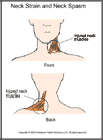
Neck Spasms
What are neck spasms?
Neck spasms are involuntary contractions of the muscles in your neck. The muscles become tight, hard, and painful.
How do they occur?
Neck spasms may occur from an injury, overuse, poor posture, or stress. For example, it is common for a person doing a lot of computer work to feel his or her neck stiffen. Spasms may even occur from an uncomfortable night's sleep.
What are the symptoms?
The muscles in your neck feel hard, tight, and painful. When the muscles that extend from your shoulders to your head go into spasm, the spasms may even cause headaches. You may have tender spots in your neck, sometimes called trigger points, that cause pain elsewhere.
How are they diagnosed?
Your health care provider will review your medical history and examine your neck.
How are they treated?
- Stretching: Spasms are best treated with stretching exercises.
- Massage: You may be able to massage your neck yourself by finding the tight muscles and putting deep pressure on these muscles. You might also get a massage from a friend or therapist.
- Medicine: Your health care provider may recommend an anti-inflammatory medicine, such as ibuprofen or naproxen, or may prescribe a muscle relaxant.
- Ice: If your neck spasm has just occurred, put ice packs on your neck for 20 to 30 minutes three to four times a day.
- Moist heat: Sometimes, especially with recurrent spasms, moist heat can help. Put warm, moist towels on your neck for 20 minutes, or take hot showers or baths.
- Physical therapy: Your health care provider may recommend seeing a physical therapist for an exercise program and other treatments.
- Injection: If the above treatments do not help the spasm get better, your health care provider may recommend a shot of an anesthetic or a medicine like cortisone into the muscle.
- Stress management: Neck spasms are a common physical symptom caused by stress or depression. Identification of these problems and treatment of them may help considerably with neck spasms.
When can I return to my sport or activity?
You may return to your sport or activity when:
- You no longer have neck pain.
- You can move your neck fully and comfortably.
How can I help prevent neck spasms?
Know what you can do about the common causes of neck spasm: overuse, stress, and poor posture. For example, use good posture at your computer terminal, take frequent breaks, and do stretching exercises.
When you first feel tightness or pain in your neck, start the treatment that has helped you the most. Treating early, mild symptoms right away can often stop the symptoms from becoming worse.

